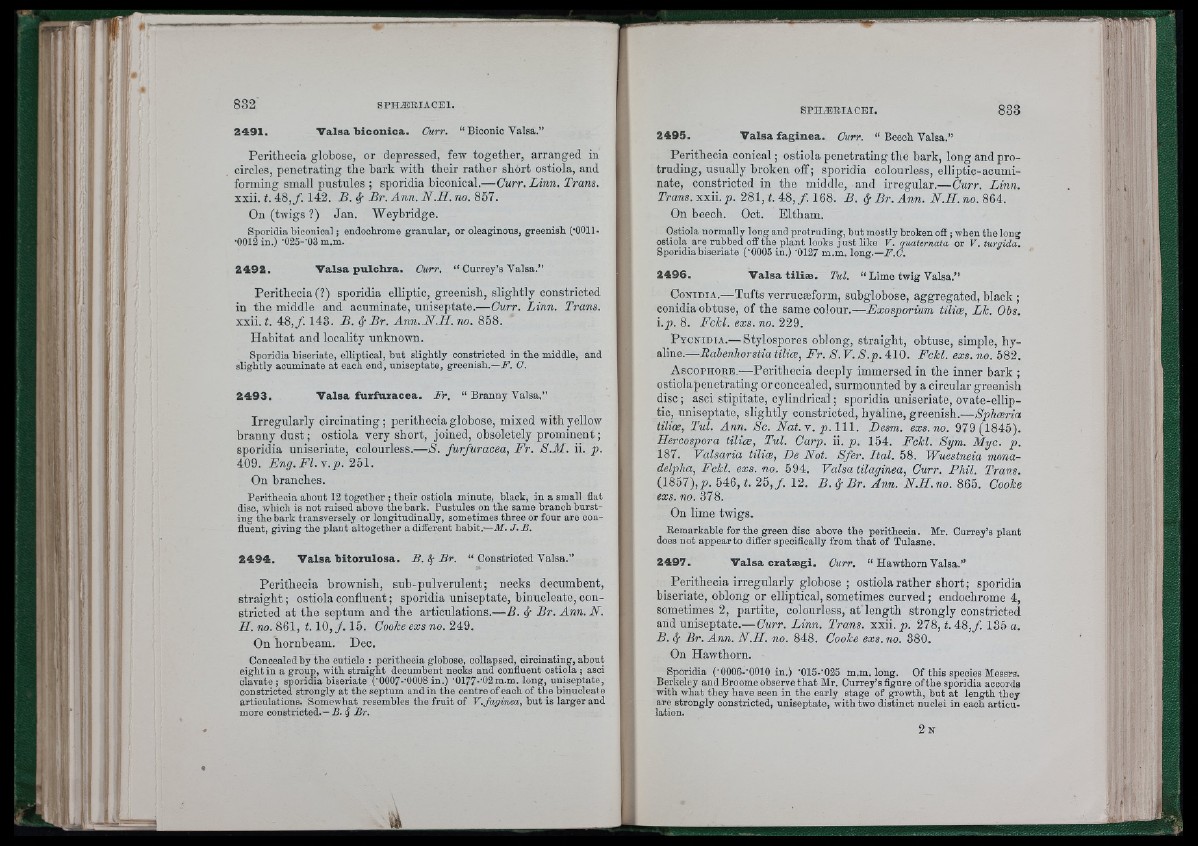
.li i
'U
J !
2 4 9 1 . V a lsa b ic o n ic a . Curr. “ Biconio Valsa.”
Perithecia globose, or depressed, few together, arranged iu
circles, penetrating the bark with their rather short ostiola, and
forming small pustules ; sporidia biconical.—Curr. Linn. Trans.
xxii. t. 4 8 ,/. 142. B. & Br. Ann. N .H . no. 857.
On (twigs ?) Jan. Weybridge.
Sporidia biconical ; endochrome granular, or oleaginous, greenish ('OOll.
•0012 in.) •025--03m.m.
2 4 9 2 . V a lsa pu lcb z a . Curr. “ Currey’s Valsa.”
Perithecia ("?) sporidia elliptic, greenish, slightly constricted
in the middle and acuminate, uniseptate.—Curr. Linn. Trans.
xxii. t. 48,/. 143. B. & Br. Ann.N.H. no. 858.
Habitat and locality unknown.
Sporidia biseriate, elliptical, but slightly constricted in tbe middle, and
slightly acuminate at each end, uniseptate, g re e n ish .—jr . C.
2 4 9 3 . V a lsa fu z fu z ac e a . Fr. “ Branny Valsa.”
Irregularly circinating ; perithecia globose, mixed with yellow
branny dust; ostiola very short, joined, obsoletely prominent;
sporidia uniseriate, colourless.— S. furfuracea, Fr. S.M. ii. p.
409. F n g .F I .y .p. 251.
On branches.
Perithecia about 12 together ; tbeir ostiola minute, black, in a small flat
disc, which is not raised above tbe bark. Pustules on tbe same branch bursting
tbe bark transversely or longitudinally, sometimes three or four are confluent,
giving tbe plant altogether a different babit.'—M. J .B .
2 4 9 4 . Valsa bitozulosa. JB. & Br. “ Constricted Valsa.”
Perithecia brownish, snb-pulverulent; necks decumbent,
straight ; ostiola confluent ; sporidia uniseptate, binucleate, constricted
at the septum and the articulations.—B. & Br. Ann. N.
H. no. 861, 1.1 0 , / 15. Cookeexs no. 249.
On hornbeam. Dec.
Concealed by the cuticle : perithecia globose, collapsed, circinating, about
eight in a group, with straight decumbent necks and confluent ostiola ; asci
clavate ; sporidia biseriate (’OOOZ-’OOOS in.) ’0177-’02 m.m. long, uniseptate,
constricted strongly at the septum and in the centre of each of the binucleate
articulations. Somewhat resembles the fruit of V.faginea, but is larger and
more constricted.— B. 4 Br.
2 4 9 5 . V a lsa fa g in e a . Curr. “ Beech Valsa.”
Perithecia conical ; ostiola penetrating the bark, long and protruding,
usually broken off; sporidia colourless, elliptic-acuminate,
constricted in the middle, and irregular.—Curr. Linn.
Trans, xxii.yi. 281, t. 4 8 ,/. 168. B. & Br. Ann. N.H. no. 864.
On beech. Oct. Eltham.
Ostiola normally long and protruding, but mostly broken off ; when the long
ostiola are rubbed off the plant looks just lilce V. quaternata or Y . turgida.
Sporidia biseriate (’0005 in.) ’0127 m.m. long.—UO.
2 4 9 6 . V a lsa t iliæ . Tul. “ Lime twig Valsa.”
C o n i d i a .— Tufts verrucæform, subglobose, aggregated, black ;
conidia obtuse, of the same colour.—Fxosporium tiliæ, Lk. Obs.
\.p. 8. Fckl. exs. no. 229.
P y c n i d i a .— Stylospores oblong, straight, obtuse, simple, hyaline.—
Rabenhorstia tiliæ, Fr. S. V. S.p. 410. Fckl. exs. no. 582.
A s o o p h o k b .— Perithecia deeply immersed in the inner bark ;
ostiolapenetrating or concealed, surmounted by a circular greenish
disc ; asci stipitate, cylindrical ; sporidia uniseriate, ovate-elliptic,
uniseptate, slightly constricted, hyaline, greenish.— Sphæria
tiliæ, Tul. Ann. Sc. Nat.Y. p . l l l . Hesm. exs.no. 979 (1845).
Hercospora tiliæ, Tul. Carp. ii. p. 154. Fckl. Sym. Myc. p.
187. Valsaria tiliæ. De Not. Sfer. Ital. 58. Wuestneia mnna-
delpha, Fckl. exs. no. 594. Valsa tilaginea, Curr. Phil. Trans.
(1857),79. 546, t. 25, f . 12. B .& B r . Ann. N.H.no. 865. Cooke
exs. no. 378.
On lime twigs.
Remarkable for the green disc above the perithecia. Mr. Currey’s plant
does not appear to differ speoifically from th a t of Tulasne.
2 4 9 7 . V a ls a c z a tæ gi. Curr. “ Hawthorn Valsa.”
Perithecia irregularly globose ; ostiola rather short; sporidia
biseriate, oblong or elliptical, sometimes curved; endochrome 4,
sometimes 2, partite, colourless, at length strongly constricted
and uniseptate.— Curr. Linn. Trans, xxii. p. 278, t. 48,/. 135 a.
B. & Br. Ann. N.H. no. 848. Cooke exs. no. 380.
On Hawthorn.
Sporidia (’0006-’0010 in.) ’015-’025 m.m. long. Of this species Messrs.
Berkeley and Broome observe th at Mr. Currey’s figure of the sporidia accords
with what they have seen in the early stage of growth, but at length they
are strongly constricted, uniseptate, with two distinct nuclei in each articulation.